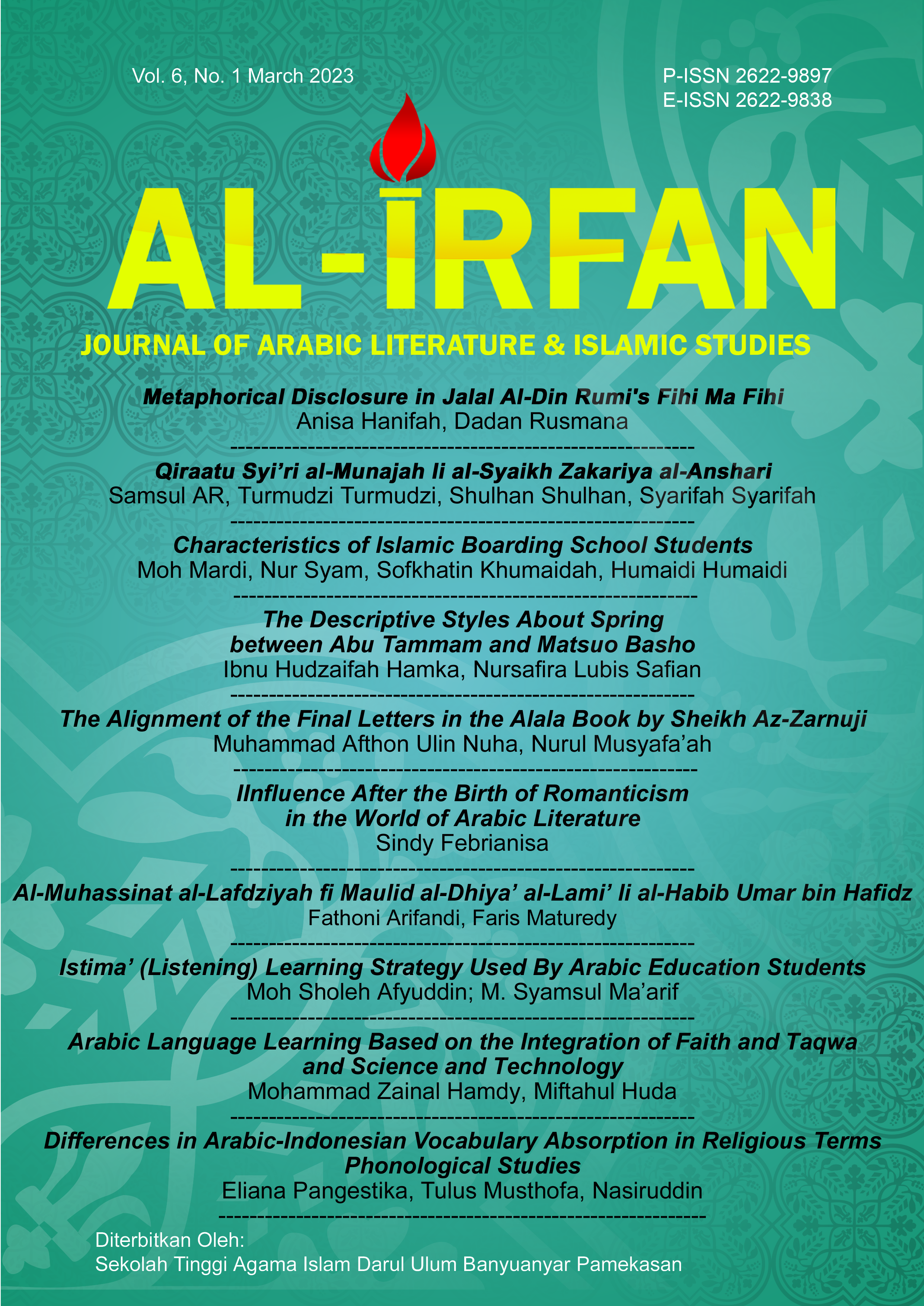English
DOI:
https://doi.org/10.58223/alirfan.v6i1.5661Kata Kunci:
EnglishAbstrak
The aim of this research is to elaborate Rumi's metaphorical disclosure in one of his works, entitled Fihi Ma Fihi. The complexity of diction in his literary work can characterize as imagery, specifically as metaphor. Jalal Al-Din Rumi was distinguished by his works containing exquisite language, the unlikeness of his figurative language and imagery, placing him as Persian Poet Top Seller in America in 1997. Therefore, this research utilize the theoretical criticism method in elaborating language and disclosure of Rumi's dialectics in Fihi Ma Fihi. As supporting to approach the analysis, this research also requires library technical and comparative literature methods. The results of this research managed to describe several metaphors that Rumi used as a religious disclosure based on his lectures. Hence, the advantage of this research will be useful for literary devotee in understanding and studying Rumi's writing tactics in influencing the world society for over centuries. This research is also expected to be a basis for further analysis of electing language in literary works production.Referensi
Abdusshomad, A. (2020). Penerapan Sifat Qanaah dalam Mengendalikan Hawa Nafsu Duniawi. Jurnal Asy-Syukriyyah, 21(1), 21–33.
Abrams, M. H., & Harpham, G. G. (2013). A Glossary of Literary Terms. Cengage Learning.
Amini, N., & Naimah, D. (2020). Faktor Hereditas dalam Mempengaruhi Perkembangan Intelegensia Anak Usia Dini. Jurnal Buah Hati, 7(2), 108.
Ansari, Z. A. (2018). Rumi: The Sufi Mystic Poet of Persian Language. International Journal of Applied Social Science, 5(12), 2302–2306.
Arasteh, A. R. (2008). Rumi The Persian, The Sufi (First). Routledge.
Bassnett, S. (1993). Comparative Literature: A Critical Introduction. Wiley-Blackwell.
Bisri, M. R. U. (2020). Tafsir Ilmu tentang Mengelola Waktu. Al-Hasanah: Jurnal Pendidikan Agama Islam, 5(2), 44–52.
Cameron, L., & Graham, L. (1999). Researching and Applying Metaphor. Cambridge University Press.
Chittick, W. C. (2005). The Sufi Doctrine of Rūmī: Illustrated Edition (Illustrated Edition). World Wisdom.
Fadlurrohim, I., Husein, A., Yulia, L., Wibowo, H., & Raharjo, S. T. (2019). Memahami Perkembangan Anak Generasi Alfa di Era Industri 4.0. Focus: Jurnal Pekerjaan Sosial, 2(2), 178–186.
Farquhar, M. (2017). Circuits of Faith: Migration, Education, and the Wahhabi Mission. Stanford University Press.
Frishkopf, M. (2003). Authorship in Sufi Poetry. Alif: Journal of Comparative Poetics, 23, 78–108. http://www.jstor.org/stable/1350077
Glucksberg, Sam., & McGlone, M. S. (2001). Understanding figurative language : from metaphors to idioms. Oxford University Press.
Guttenplan, S. (2005). Objects of Metaphor. Oxford University Press.
Herawati, A. (2014). Maslahat Menurut Imam Malik dan Imam al-Ghazali (Studi Perbandingan). Diktum: Jurnal Syariah Dan Hukum, 12(1), 42–54.
Iqbal, A. (1991). LIFE AND WORK OF JALALUDDIN RUMI (Sixth). Pakistan National Council of the Arts.
Jalal Al-Din Rumi. (2007). The Masnavi (J. Mojaddedi, Ed.; Vol. 2). Oxford University Press.
Jalil, M. H., Stapa, Z., & Samah, R. A. (2016). Konsep Hati Menurut al-Ghazali. Jurnal Reflektika, 59(11), 59–71.
Katz, A. N., Cacciari, C., Gibbs, R. W., & Turner, M. (1998). Figurative Language and Thought (Counterpoints, Cognition, Memory and Language). Oxford University Press.
Lewis, F. D. (2000). Rumi: Past and Present, East and West. Oneworld Publications.
Medaglia, J. D., Zurn, P., Sinnott-Armstrong, W., & Bassett, D. S. (2016). Mind Control as a Guide for the Mind. http://arxiv.org/abs/1610.04134
Mu’izzuddin. Mochammad. (2016). Berpikir Menurut al-Qur'an . Studi Didaktika: Jurnal Ilmiah Pendidikan, 10(1), 1–13.
Nasr, S. H. (1974). Rūmī and the Sufi Tradition. Studies in Comparative Religion, 8(2), 1–18. www.studiesincomparativereligion.com
Okuyucu, Cihan. (2007). Rumi : biography and message. The Light.
Rohmawati, F. (2020). Studi Penafsiran Lafadz Khusyu’ dalam Tafsir Ibnu Katsir (Interpretation Study Of The Term Khusyû’ In Tafsir Ibn Katsir). Jurnal Studi Ilmu Al-Qur’an Dan Tafsir, 2(2), 32–40.
Rumi, J. (2014). Fihi Ma Fihi: Mengarungi Samudera Kebijaksanaan (A. Kholiq, Ed.). FORUM.
Sany, U. P. (2019). Prinsip-Prinsip Pemberdayaan Masyarakat dalam Perspektif Al Qur’an. Jurnal Ilmu Dakwah, 39(1), 32–44.
Sigelman, C. K., & Rider, E. A. (2011). Life-Span Human Development, Seventh Edition (J. Perkins, Ed.; Seventh). Wadsworth.
Sulman, & Hamzah, N. A. (2019). Ikhlas dalam Beribadah Sesuai Tuntunan al-Qur’an dan Hadits. Jurnal Ushuluddin Adab Dan Dakwah, 2(1), 65–73. https://doi.org/10.5281/zenodo.3541398
Wines, L. (2000). Rumi: A Spiritual Bioghraphy. The Crossroad Publishing Company.
##submission.downloads##
Diterbitkan
Cara Mengutip
Terbitan
Bagian
Lisensi
Hak Cipta (c) 2023 Anisa Hanifah, Dadan Rusmana

Artikel ini berlisensi Creative Commons Attribution 4.0 International License.
Lisensi :
Al-Irfan: Journal of Arabic Literature and Islamic Studies is published under conditions Creative Commons Attribution 4.0 International License / CC BY 4.0 This license permits anyone to copy and redistribute this material in any form or format, modify, modify, and make derivative works of this material for any purpose, including commercial purposes, so long as they credit the author for the original work.











